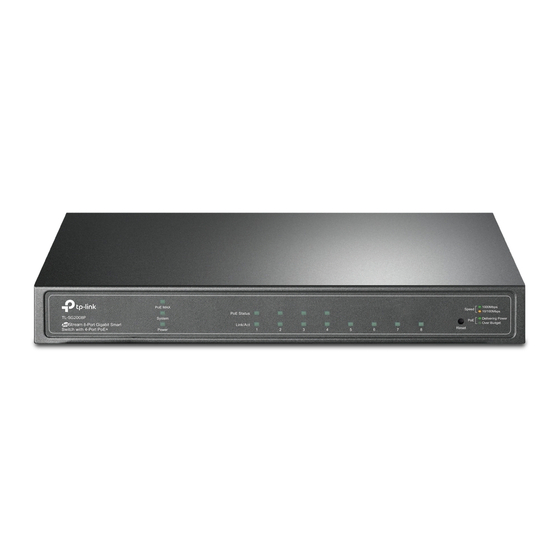Table of Contents
Advertisement
Quick Links
Installation Guide
JetStream Gigabit Smart PoE+ Switch
For simplicity, we will take TL-SG2210P for example throughout the Guide.
Connection
3
AC Power Cord
2
DC Power Adapter
Note:
1. PoE ports can also connect to non-PoE devices, but only transmit data.
2. Maximum PoE power is 30 W for each PoE port, and 62 W (for TL-SG2008P)/61 W (for TL-SG2210P) for all PoE ports.
3. PoE budget calculations are based on laboratory testing. Actual PoE power budget is not guaranteed and will vary as a result of client limitations and environmental factors.
Configuration
The switch supports two configuration methods:
Standalone Mode: Configure and manage the switch singly.
Controller Mode: Configure and manage the network devices centrally. It is recommended in the large-scale network, which consists of mass devices such as
access points, switches, and gateways.
Note: When the switch is changed from Standalone Mode to Controller Mode, configurations of the switch will be lost. For details, refer to the related documents on the download center of our
official website: https://www.tp-link.com/support/download/.
Method 1: Standalone Mode
In Standalone Mode, use a computer to configure and manage the switch.
Switch
1
PC
PC
LED Explanation
Power
On:
Power on
Off:
Power off
System
Flashing:
System running normally
On/Off:
System running abnormally
Link/Act (port 1–8)
On (Green):
Running at 1000 Mbps
On (Yellow):
Running at 10/100 Mbps
Flashing:
Transmitting/receiving data
Off: No connected device
SPF1/SFP2
(for TL-SG2210P)
On (Green):
Running at 1000 Mbps
On (Yellow):
Running at 100 Mbps
Flashing: Transmitting/receiving data
Off: No connected device
Ethernet Ports (1–8)
PoE Devices
IP Camera
AP
1. To access the management page of the switch, open a browser and type
the switch's IP address in the address field, then press the Enter key.
If the switch obtains IP address from the DHCP server (typically a router), find
the switch's IP address on the DHCP server.
If not, use the default IP address 192.168.0.1 to launch the switch's
management page.
Note: Make sure the switch and computer are in the same subnet.
2. Enter admin for both the username and password in the lower case letters
to log in. The first time you log in, change the password to better protect
your network and devices.
3. After a successful login, the main page will appear. You can click the menus
on the top side and left side to configure the corresponding functions.
For the detailed configurations, refer to the User Guide and CLI Guide. The
guides can be found on the download center of our official website:
https://www.tp-link.com/support/download/.
PoE Status
For Port 1-4 of TL-SG2008P/Port 1-8 of TL-SG2210P
On:
Providing PoE power
Flashing:
Current-overload/Short-circuit/Connected
to a non-standard PD/Power exceeded the
user-defined value
Off:
Not providing PoE Power
PoE MAX
For TL-SG2008P
On:
55 W ≤ Total power supply < 62 W
Flashing:
Total power supply keeps ≥ 55 W more than
2 minutes
Off:
Total power supply < 55 W
For TL-SG2210P
On:
54 W ≤ Total power supply < 61 W
Flashing:
Total power supply keeps ≥ 54 W more than
2 minutes
Off:
Total power supply < 54 W
SFP Slots
IP Phone
Advertisement
Table of Contents

Summary of Contents for TP-Link TL-SG2008P
- Page 1 1. PoE ports can also connect to non-PoE devices, but only transmit data. 2. Maximum PoE power is 30 W for each PoE port, and 62 W (for TL-SG2008P)/61 W (for TL-SG2210P) for all PoE ports. 3. PoE budget calculations are based on laboratory testing. Actual PoE power budget is not guaranteed and will vary as a result of client limitations and environmental factors.
- Page 2 TP-Link ID. Type 1: Via Web Browser b. Launch Omada App and log in with your TP-Link ID. Then go to Cloud 1. Open the Omada Controller’s web page. Access. A list of controllers that have been bound with your TP-Link ID will appear.














Need help?
Do you have a question about the TL-SG2008P and is the answer not in the manual?
Questions and answers